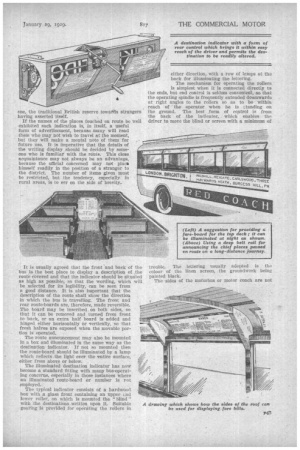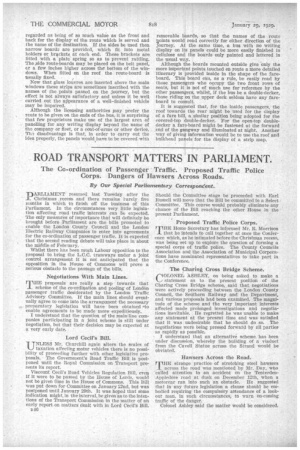ROUTE-BOARDS
Page 28

Page 29

Page 30

If you've noticed an error in this article please click here to report it so we can fix it.
and
DESTINATION INDICATORS.
TBE bus proprietor offers transport service and if his vehicles are to be readily patronized the particular route covered should be boldly and concisely described by means of route-boards and destination indica The paSsenger who makes use of a certain route regularly 'may have forgotten the time when he was unfamiliar with it, but he may be reminded of the fact when he has occasion to make a different journey. He then takes special notice of the details given of the new route and their adequacy is proved according to whether he has to seek information from the conductor before mounting the bus, or, on the other hand, feels confident from what he has read that he is on the right bus.
The stranger in London, once in possession of acopy of the bus-route map, which is supplied free of charge, is able to travel extensively in Greater London with little occasion to ask questions. He does not have even to read a route-board, but has only to take note
of a certain route number, which is displayed in prominent positions on the vehicle. The use of route numbers has proved to be a great convenience to passengers, -whether they be regular travellers or not. The route number is a means for recognizing at once a certain bus service and it simplifies matters considerably when directions for a journey are being given. , In London. the use of route numbers became a necessity, owing to the continual increase in the number of routes served.. The old method of distinguishing • routes by means of different colours of bus or the adoption of special names written in -large letters on the side panels, was a practice which 'had its limitations. The route number being independent of the eolour of the vehicle standardizationwas possible, a result which some, who would like to see the old variety -of painting revived, may deplore. One colour for all the fleet, however, is a factor which helps to reduce the cost of maintenance. In this connection it is interesting to note that the horse buses of the London General Omnibus Co., no ,matter what colour the body was painted, always had yellow wheels. This was done to facilitate interchangeability.
In the absence of the display of a route number and the distribution of route maps, the traveller has to depend on the information given on the vehicle itself.. If inquiries have to be made continually it tends to cause delay, because a passenger will often ask questions during a busy period ; he will, perhaps, hail and stop the vehicle unnecessarily, or he may be travelling on the wrong bus, because be has not consulted any one, the traditional British reserve towards strangers having asserted itsgf.
If the names of the places touched en route be well exhibited such indication is, in itself, a useful form of advertisement, because many will read them who may not wish to travel at the moment, but they will make a mental note of them for future use. It is imperative that the details of the writing display should be decided by someone who is familiar with the route. This dose acquaintance may not always be an advantage, because the official concerned may not placie himself readily in the position of a stranger to the district. The number of items given must be restricted, but the tendency, especially in rural areas, is to err on the side of brevity._
It is usually agreed that the front and back of the bus is the best place to display a description of the route covered and that the indicator should be situated as high as possible, so that the wording, which will be selected for its legibility, can be seen from a good distance. It is also important that the description of the route shall show the direction in which the bus is .travelling. The front and rear route-boards are, therefore, made reversible. The board may be inscribed . on both sides, so that it can be removed and turned from front to back, or an extra half board is added and hinged either horizontally br vertically, so that fresh halves are exposed when the movable portion is operated.
The route announcement may also be mounted in a box and illuminated in the same way as the destination indicator. If not so mounted then the route43oard should be illuminated by a lamp which reflects the light over the entire Surface, either Aviv' above or below.
The illuminated destination indicator has now become a standard fitting with many bus-operating concerns, especially in those instances where an illuminated route-board or number is rot employed.
The typical indicator consists of a hardwood box with .a glass front containing an upper and lower roller, on which is mounted the " blind " with the destinations..written upon it. Suitable gearingl.S provided for operating the rollers in either direction, with a row of lamps at the back for illuminating the lettering.
The mechanism for operating the rollers is simplest when it is connected directly to the ends, but end control is seldom convenient, so that the operating spindle is frequently extended downwards at• right ankles to the rollers so as to be within reach of the operator when he is trending on the ground. The best ,form of control is from the back of the indicator, which enables the driver to move the blind or screen with a minimum of regarded as being of so much value as the front and back for the display of the route which is served and the name of the destination. If the sides be used then narrow boards are provided, which fit into metal holders or brackets at each end. These brackets are fitted with a 'plate spring so as to prevent rattling. The side route-boards may be placed on the belt panel, or a few inches higher across the bottom of the windows. When fitted on the roof the route-board is usually fixed.
Now that glass louvres are inserted above the main windows these strips are sometimes inscribed with the names of the points passed on the journey, but the effect is not always satisfactory and unless it be well carried out the appearance of a well—finished vehicle may be impaired.
Although the licensing authorities may prefer the route to be given on the ends of the bus, it is surprising that few proprietors make use of the largest area of panelling for any writing display beyond the name of the company or fleet, or a coat-of-arms or other device. Ths disadvantage is that, in order to carry out the Idea properly, the panels would have to be covered with removable boards, so that the names of the route points would read correctly for either direction of the journey. At the same time, a bus with no writing display on its panels could be more easily finished In cellulose and the boards only painted and lettered in the usual. way.
• Although the boards mounted outside give only the more important points touched en route a more detailed itinerary is provided inside in the shape of the fareboard. This board can, as a rule, be easily read by those passengers who occupy the two front rows of seats, but it is not of much use for reference by the other passengers, whilst, if the bus be a double-decker, those riding on the upper deck seldom have any fareboard to consult.
It is suggested that, for the inside passengers, the roof towards the rear might be used for the display of a fare bill, a similar position being adopted for the covered-top double-decker. For the open-top doubledecker a fare-board might be fastened at the forward end of the gangway and illuminated at night. Another way of giving. information would be to use the roof and bulkhead pailiels for the display of a strip map.


































